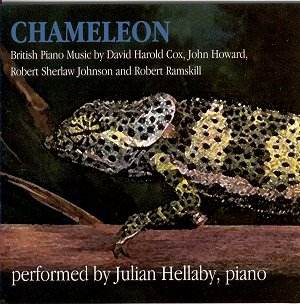If
looking for a factor to bind this disc together it could possibly
be the City of Coventry. Julian Hellaby is currently Associate
Senior Lecturer at Coventry University whilst Robert Ramskill,
although born in Leeds, has been a lecturer at Coventry Centre
for the Performing Arts (formerly Coventry School of Music) since
1975. In addition Ramskillís Nocturne was written in 1987
for Eileen Sier, a London-based pianist who was a part-time piano
teacher at the school for many years.
The
piece that lends its title to the disc, Robert Ramskillís Chameleon,
is also the most substantial of the works at just over twenty-one
minutes. Falling naturally into six continuous sections, Ramskill
uses each of the sections to explore differing aspects of often-related
musical material, hence the title. As he explains in his programme
note, the "colour" associated with the chameleon is
interpreted in harmonic terms or equally by clearly defining differing
registers of the keyboard, the relationships between both being
explored in related sections. The shorter of Ramskillís two works,
Nocturne, has its origins in Eileen Sierís reputation as
a Chopin specialist, the composer taking one of Chopinís favourite
forms as a starting point. Florid, dream-like material contrasts
with more rigidly organised passages and slower moving chordal
progressions in a highly effective and atmospheric evocation of
"the darkness, rather than the romance, of night".
Robert
Sherlaw Johnsonís Three Shakespearean Characters frames
a lengthy central portrait of Hamlet with more fleeting outer
character studies of Lady Macbeth and Puck. The strong, gritty
opening, depicting the self-assured personality of Lady Macbeth
quickly descends into fragmentation as madness envelops her, whilst
the possibly overlong portrayal of Hamlet uses transpositions
of a twelve-note row to represent his agonising trait of indecision.
Quotes from the preceding two movements are treated to mischievous
tampering by Puck in the final movement.
David
Harold Coxís Tendrilles 15/23/48 and John Howardís Variations
for Piano demand a little more from the listener in terms
of concentration and perseverance although both works will pay
dividends upon repeated listening. Howardís Variations
comprise a set of nine variations from which evolves a folk-like
melody that reveals itself in its entirety in the final variation.
In contrast his shorter African Toccata is something of
a showpiece drawing on the composerís musical response to a visit
to the Kruger National Park in South Africa as well as a subconscious
reaction to the sounds of African music. Coxís Tendrilles
utilise diverse thematic material given unity and structure by
the associations of a series of "pitch centres". The
15/23/48 of the title conceals an alphabetical association, the
cipher of which is a six letter word underpinning the overall
concept of the work.
Julian
Hellaby is articulate and convincing in his performances and is
to be congratulated for bringing this unfamiliar yet worthwhile
music to disc. The recorded sound is acceptable if not exactly
in the demonstration class but certainly does not detract from
a recording that offers much to interest.
Christopher
Thomas
